QR codes on banners are no longer just a passing tech trend but a crucial tool for marketers looking to enhance their advertising strategies.
In this article, we will explore how to use QR codes on banners, their benefits, and tips that can be helpful so that you can use them for your QR code ads.
Static QR Codes Vs. Dynamic QR Codes for Banners
QR codes come in two primary forms: static and dynamic. Understanding the difference between these can greatly impact the effectiveness of your marketing campaigns.
- Static QR Codes: These QR codes are fixed, meaning the data in the QR code doesn't change once it is created. If the QR code directs to a URL, that URL will always remain the same.
- Dynamic QR Codes: Unlike static codes, dynamic QR codes are flexible and can be updated to redirect to different URLs without changing the QR code itself. This flexibility is especially valuable for marketers who need to adjust their strategies based on analytics or campaign shifts.
Why You Should Use Dynamic QR Codes on Banners
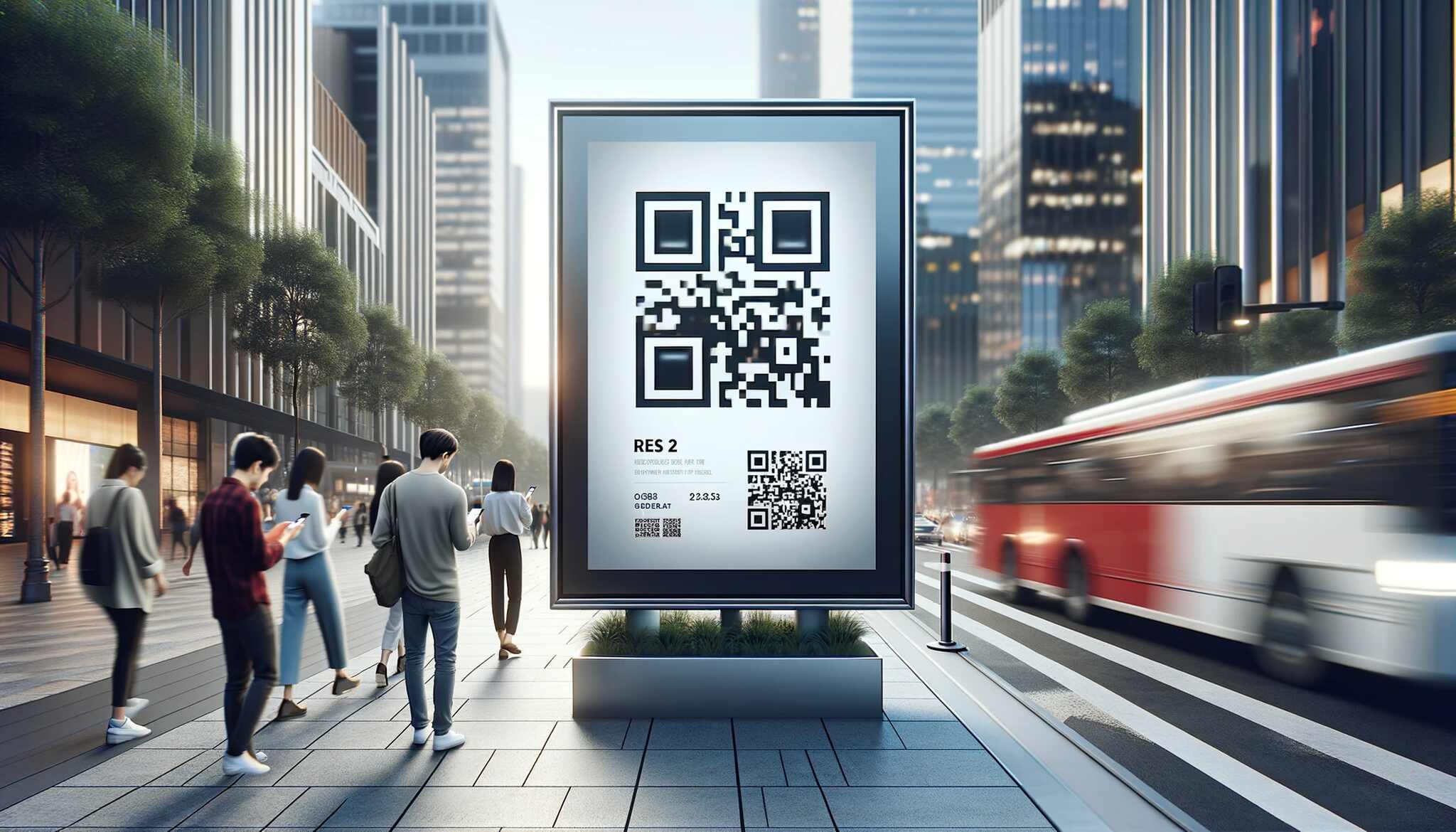
Dynamic QR codes offer several distinct advantages over their static counterparts, particularly in marketing and advertising contexts:
- Editability: You can change the destination URL without needing to reprint the QR code, saving time and resources.
- Tracking Capabilities: Dynamic QR codes allow for the tracking of scan statistics, which can provide insights into when and where the codes are scanned and how many people are scanned.
- Increased Engagement: By linking to dynamic content, you can keep your audience engaged by regularly updating the landing page with new and relevant information.
How to Create QR Codes for Banners with QRCodeDynamic
Creating effective QR codes for banners doesn't have to be complicated.
With tools like QRCodeDynamic, you can effortlessly design, customize, and deploy QR codes that look great and perform exceptionally.
Whether you're aiming to increase website traffic, enhance customer engagement, or track the success of your campaigns, QRCodeDynamic offers a robust solution.
Let's walk through the process step-by-step.
Step 1: Define Your Goal
Before you begin creating your QR code, it's important to clearly define what you want to achieve.
Are you looking to drive more traffic to your website, promote a new product, or perhaps collect user feedback?
Your goal will determine the type of QR code you should create, such as URL QR codes, event QR codes, or even email QR codes.
Step 2: Enter Your URL or Content
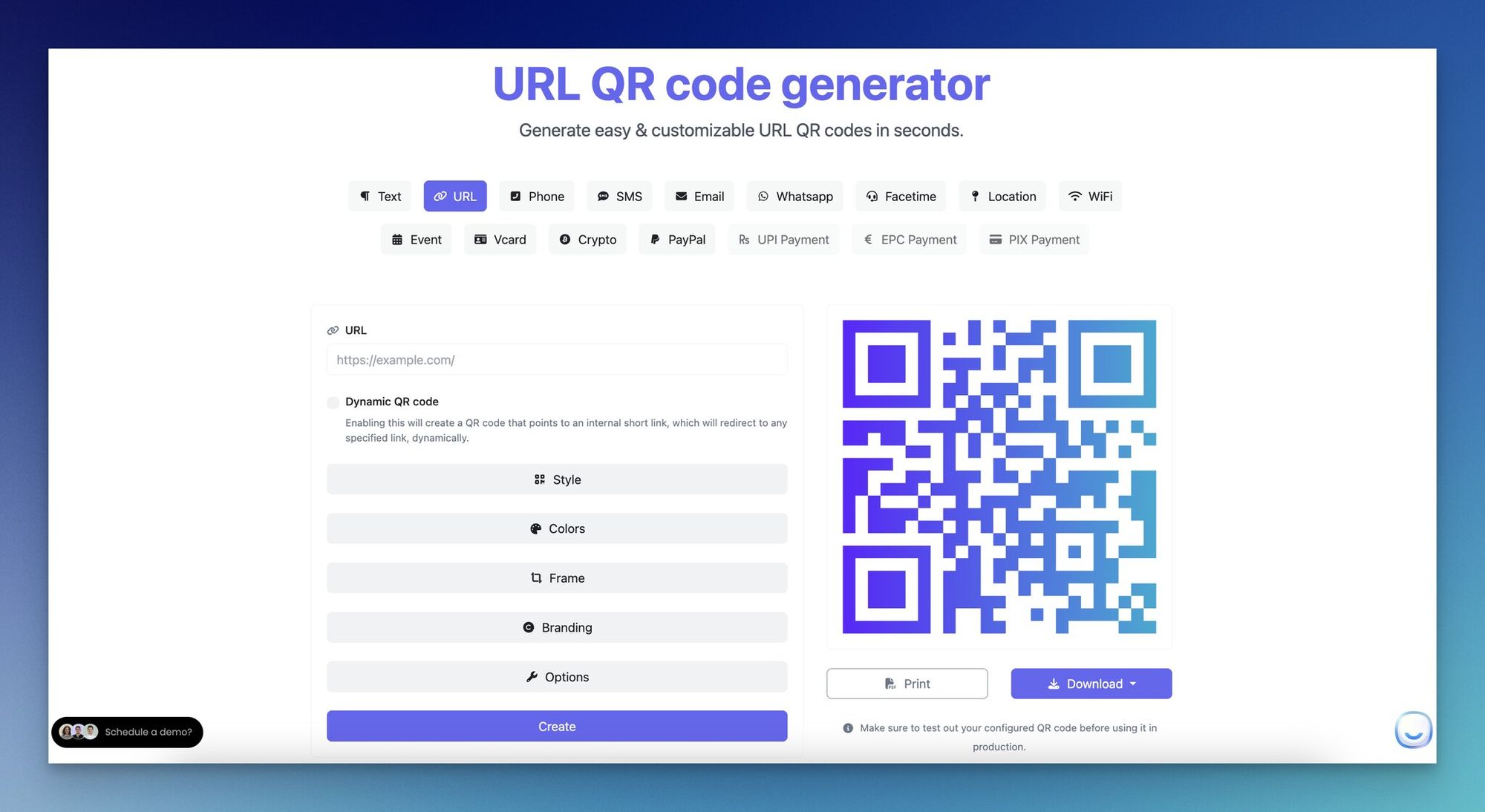
- Go to QRCodeDynamic's website: Start by navigating to the QRCodeDynamic platform.
- Input your content: Enter the URL or the content you want your QR code to link. This could be a link to a landing page, a video, a digital menu, or any digital asset.
- Select the option to create a dynamic QR code. This choice allows you to change the destination URL or content without generating a new QR code, providing flexibility and longevity for your marketing materials.
Step 3: Customize Your QR Code
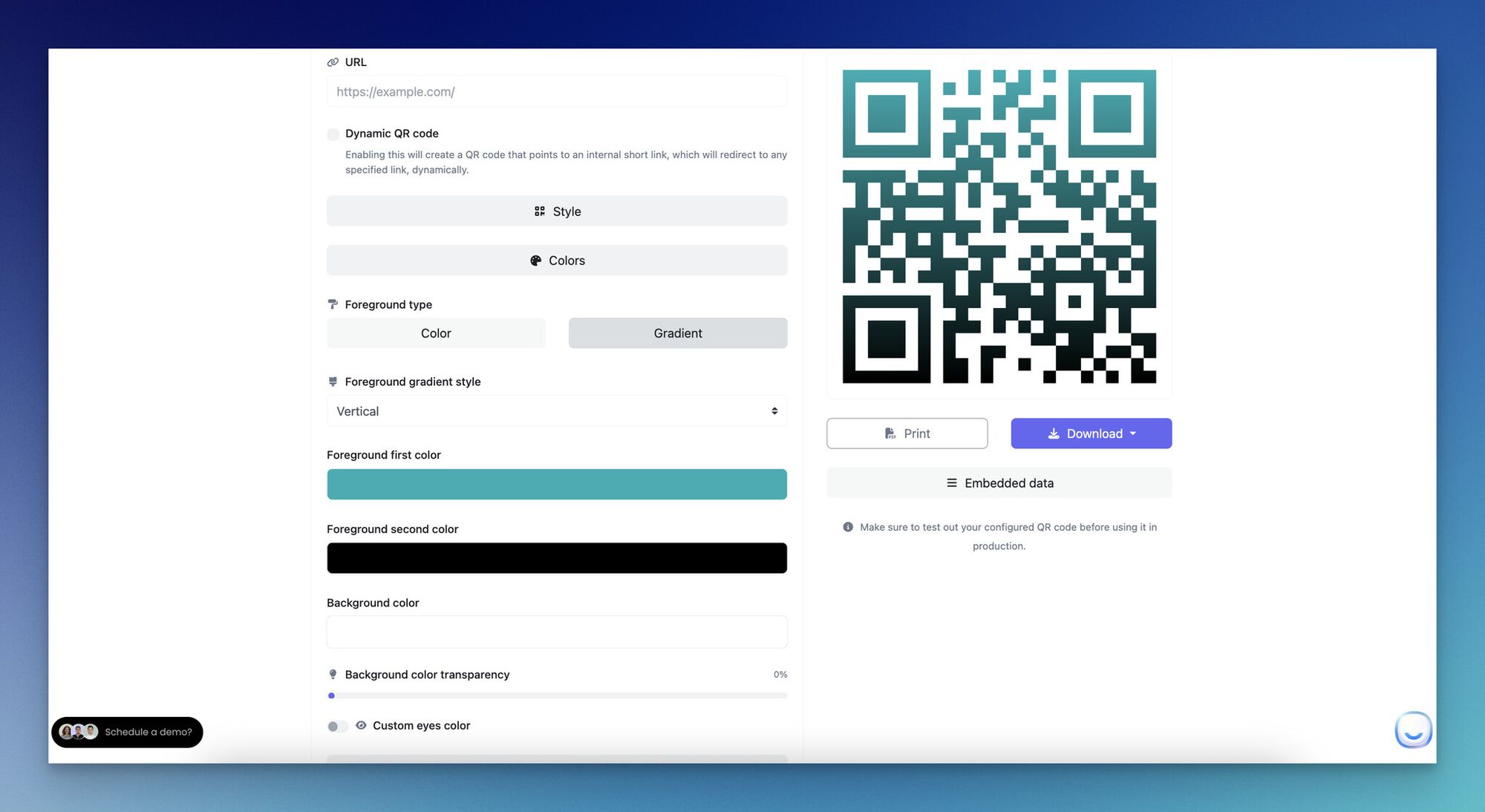
- Design: Customize the appearance of your QR code. QRCodeDynamic offers various customization options, such as changing colors, adding a logo, or adjusting the shape of the dots within the QR code to match your brand's aesthetic.
- Add a Frame and Call to Action: Incorporate a frame around your QR code and include a call to action like "Scan me!" or "Learn more here!" This can significantly increase engagement rates by making the purpose of the QR code clear to your audience.
Step 4: Test Your QR Code
Before printing and deploying your QR code on banners, it's crucial to test it:
- Multiple Devices: Scan the QR code with different smartphones and QR code scanning apps to ensure it works consistently across all potential user devices.
- Visibility and Accessibility: Make sure the QR code scans well in various lighting conditions and from different distances, mimicking how it would be displayed on a banner.
Step 5: Deploy Your QR Code on Banners
Once tested, you are ready to integrate the QR code into your banner design:
- Placement: Position the QR code where it is easily visible and accessible to potential scanners. The banner's lower third or center are usually good places, depending on the overall design.
- Size: Ensure the QR code is large enough to be scanned from a distance. A general rule is that the scanning distance is ten times the width of the QR code.
Step 6: Track and Analyze Performance
Leverage QRCodeDynamic's tracking features to monitor how your QR code is performing:
- Analytics: Use the built-in analytics to track how many times the QR code has been scanned, from which locations, and what times of day are most active. This data can help you refine your campaigns and better understand your audience.
- Adjust as Needed: Based on the data collected, make necessary adjustments to your campaign. For example, you might change the content linked to the QR code or modify the call to action to improve effectiveness.
How to Use QR Codes on Banners Effectively
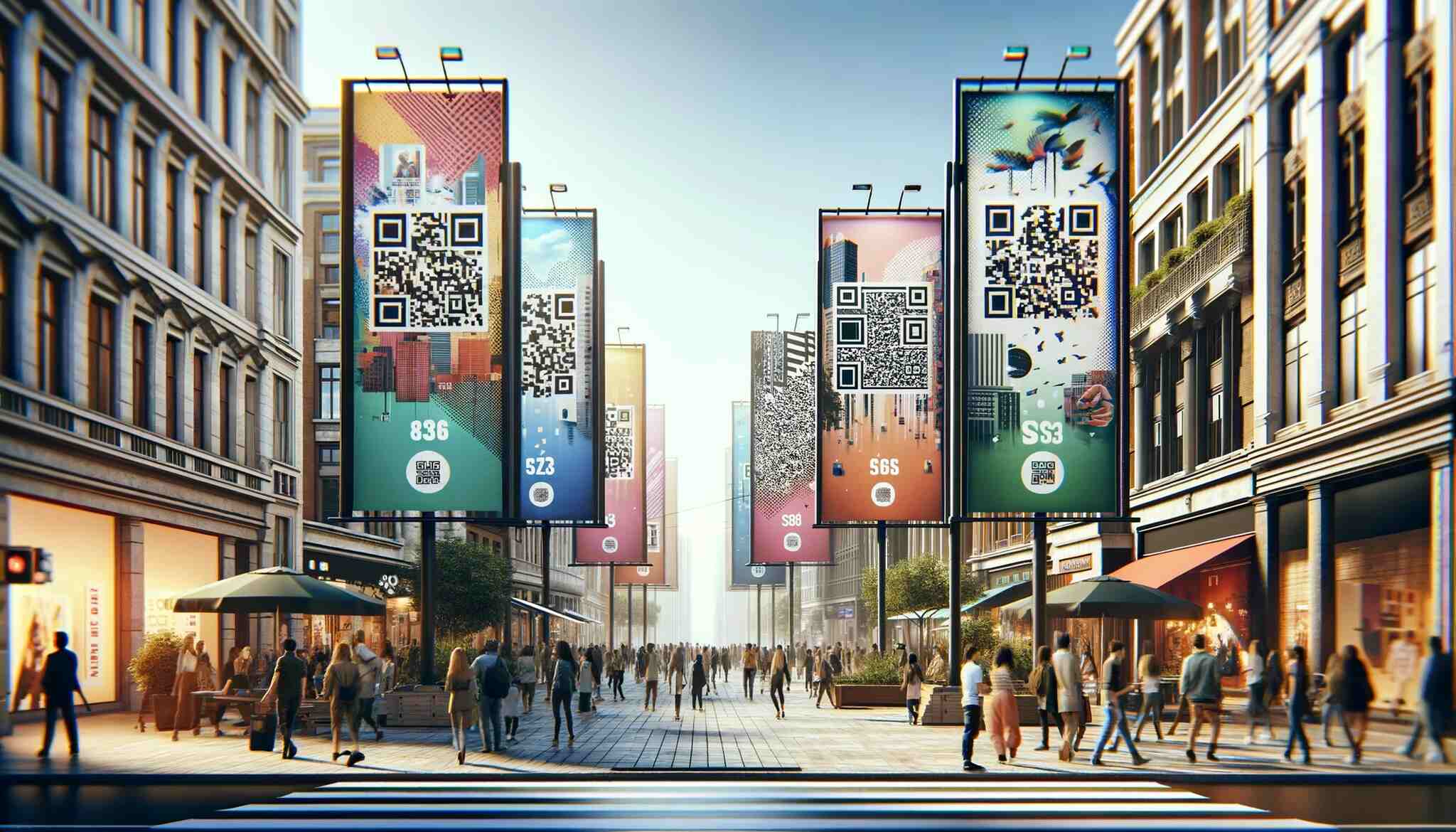
Integrating QR codes into your banners can transform static advertisements into interactive portals that engage users and drive tangible business outcomes.
However, the effectiveness of QR codes is highly dependent on how they are used. Below, we explore several strategies to ensure your QR codes capture attention and deliver value, driving website traffic, increasing downloads, and boosting social media engagement.
Drive Website Traffic with URL QR Codes
QR codes can be a powerful tool to increase website traffic. By embedding a URL QR code on your banner, you create an easy access point for potential customers:
- Direct Linking: Use QR codes to link directly to your homepage, a promotional page, or a new product launch page.
- Special Offers and Discounts: Encourage scans by linking to pages offering special discounts or exclusive content.
- Optimize the Landing Page: Ensure that the linked page is mobile-friendly, loads quickly, and is optimized for conversions. A strong call to action on this page can significantly increase engagement.
Achieving Trackable and Measurable Banner Ads
One of the key benefits of using QR codes is their ability to make offline ads trackable:
- Analytics: Use dynamic QR codes to gather data on how many people are scanning your QR codes, when, and from where.
- A/B Testing: Implement different QR codes for different banners to test which designs and locations get more traction. Adjust your strategy based on data-driven insights.
Reaching a Multi-Platform Audience
QR codes excel in bridging various platforms:
- Universal Compatibility: QR codes can be scanned by any smartphone camera, making it easy for users on different devices and operating systems to interact with your content.
- Link to Multi-Platform Content: Consider linking your QR code to a page that offers apps on both Google Play and the Apple App Store or to social media platforms where users can choose their preferred way to engage with your brand.
Cost-Efficiency of Using QR Codes
QR codes are a cost-effective marketing tool:
- Low Production Cost: Creating and printing QR codes is inexpensive, especially compared to other interactive technologies.
- Saves on Material Costs: By linking to digital content, QR codes reduce the need for physical promotional materials, lowering your overall marketing expenses.
Boost Social Media Growth with Social Media QR Codes
Enhance your social media presence by linking QR codes to your social media pages:
- Direct Links to Follow: Make it easy for users to follow your social profiles by scanning the QR code.
- Share Special Content: Link to exclusive videos or posts that can only be accessed through the QR code, incentivizing users to follow your pages for more updates.
Increase Mobile App Downloads with App Store QR Codes
If you have a mobile app, QR codes can directly increase downloads:
- Direct App Store Links: Use QR codes that link directly to your app's download page on the App Store or Google Play.
- Promote App Features: Use the banner to highlight key features of your app that will entice users to download it.
Promote Your Brand with Multi-URL QR Codes
Multi-URL QR codes can direct users to different links based on their location, device, or the time of scan:
- Target Content: Deliver customized content that is more relevant to the user's context, increasing engagement and satisfaction.
Provide Complete Details with File QR Codes
Use QR codes to provide detailed information through downloadable files:
- Product Manuals, Brochures, and More: Enable users to download PDFs directly to their devices, providing them with detailed information that would be too much to include on the banner itself.
Getting Valuable Feedback with Google Form QR Codes
Collecting feedback is crucial for any business:
- Direct Links to Feedback Forms: Use QR codes to link directly to a Google Form where customers can leave feedback, helping you improve your products and services based on user input.
Enhancing Brand Storytelling with Video QR Codes
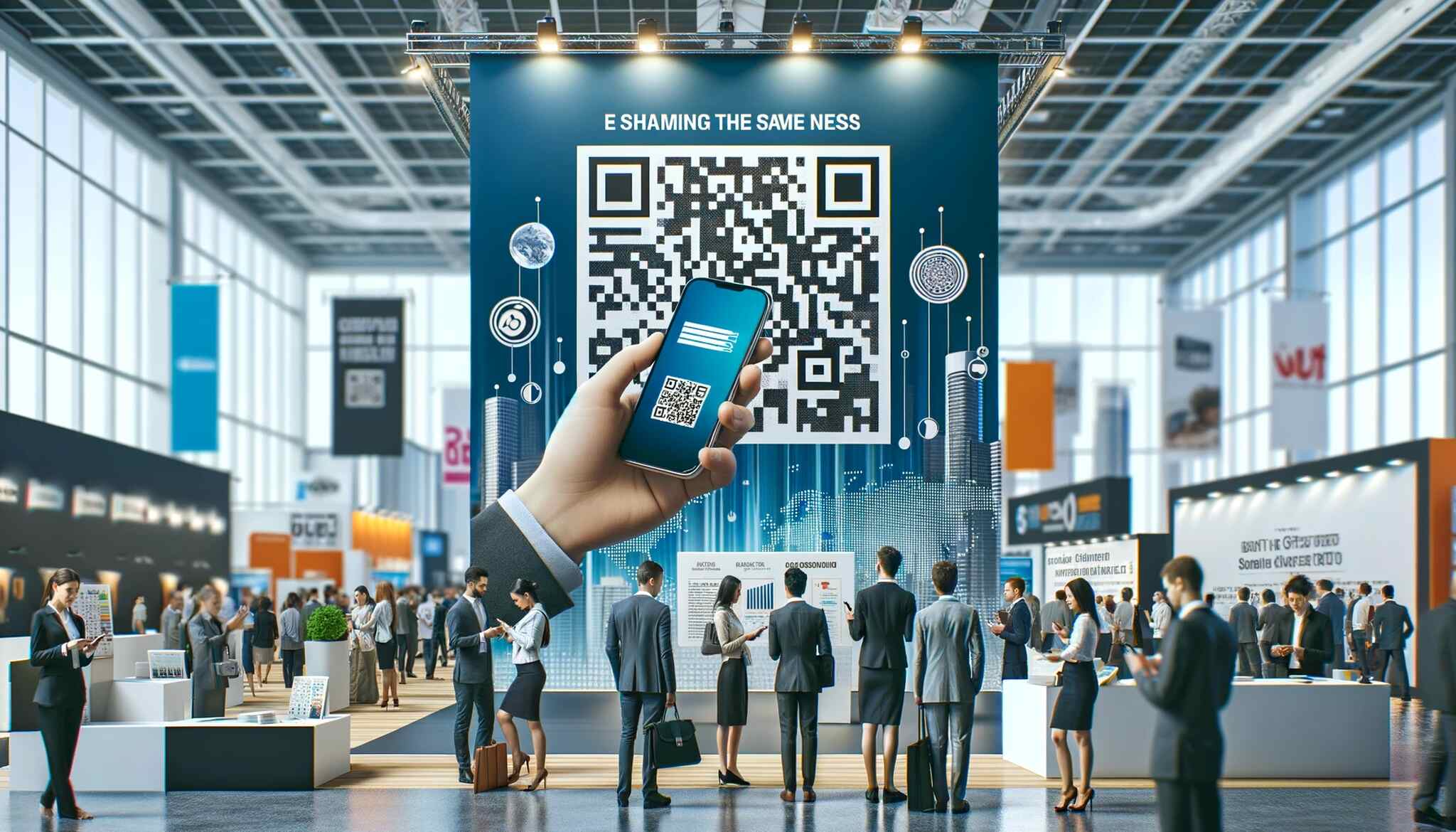
Tell your brand's story through video:
- Engaging Visual Content: Link your QR code to a video that tells your brand story or showcases your products in action, creating a deeper emotional connection with the viewer.
Captivate the Audience with Audio QR Codes
Audio content can also be an effective tool:
- Podcasts and More: Link to audio content like podcasts or music that enhances the user's understanding of your brand or products.
How Different Industries Can Use QR Codes on Banners
QR codes have become a versatile tool across various industries, transforming traditional banner advertising into a dynamic interface between companies and their customers.
By incorporating QR codes into their banners, businesses can enhance user engagement, track marketing effectiveness, and bridge the gap between offline and online media. Below, we explore how different sectors can leverage QR codes effectively.
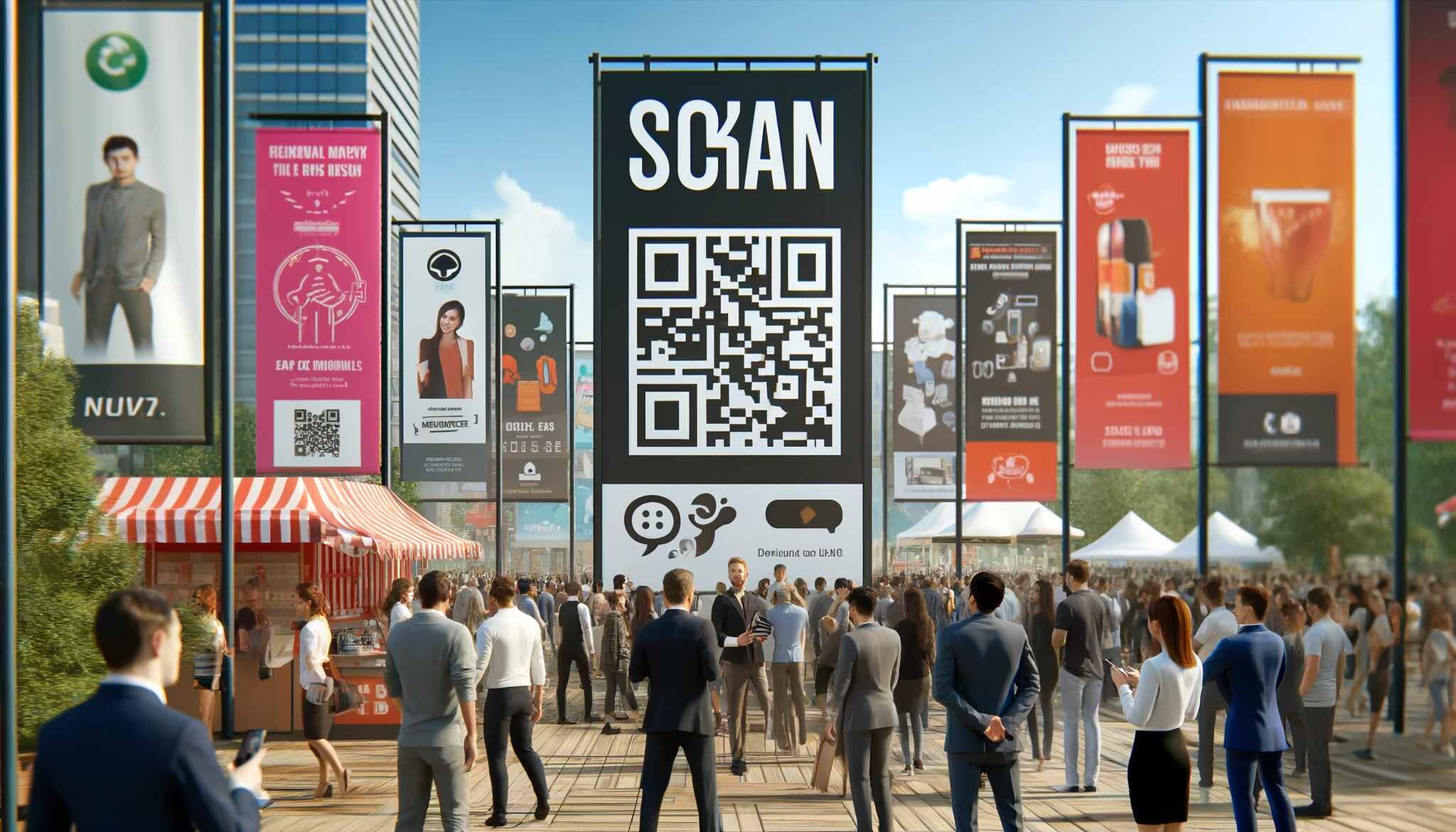
Business Consultants
For business consultants, QR codes can be an excellent way to share professional profiles, case studies, or white papers directly through banners at conferences or seminars.
- Lead Generation: Place QR codes on banners at networking events to direct potential clients to a contact form.
- Sharing Expertise: Link to downloadable content like industry analysis reports or eBooks to establish authority and share knowledge.
Retailers
Retailers can use QR codes to create a seamless shopping experience, promote sales, and track consumer behavior.
- Product Details and Reviews: Link QR codes to detailed product information or customer reviews to help shoppers make informed decisions.
- Exclusive Discounts: Encourage store visits by linking QR codes to special in-store discounts or loyalty program sign-ups.
Software & Game Development Companies
Software and gaming industries can use QR codes to drive app downloads, share updates, or provide exclusive content.
- Direct Downloads: Use QR codes on banners at tech expos or in tech malls to link directly to the app or game downloads.
- Beta Testing Invitations: Invite users to test new features or games by linking to a sign-up page through a QR code.
Tourism Industry
Tourism sectors can enhance visitor experiences by integrating QR codes into their promotional materials.
- Interactive Tours: Link QR codes on city or museum banners to audio guides or interactive maps.
- Event Schedules: Direct tourists to a mobile site with updates on local events, special exhibits, or festivals.
Educational Institutions
Schools, colleges, and educational services can use QR codes to inform, engage, and connect with students, parents, and the community.
- Admissions and Registrations: Link to online admission forms or registration pages for workshops and courses.
- Educational Resources: Provide access to learning materials, course syllabi, or educational videos.
The Benefits of Using QR Codes on Banners
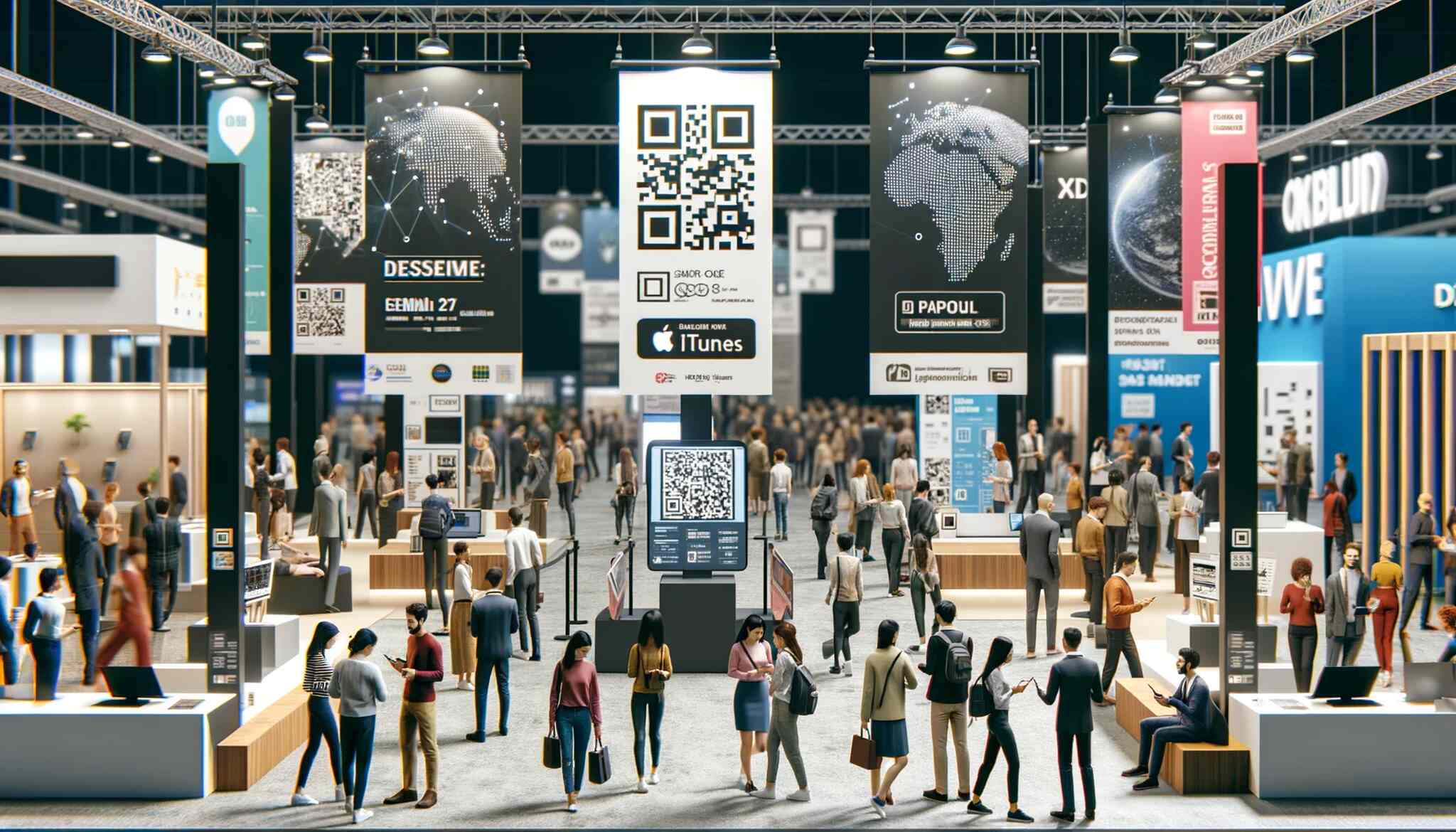
QR codes have revolutionized the way businesses engage with consumers, offering a seamless blend of physical and digital marketing strategies.
By incorporating QR codes into banners, companies can enjoy many benefits that enhance both customer engagement and marketing effectiveness.
Let's explore the myriad advantages of using QR codes on banners.
Immediate Engagement
QR codes transform passive observers into active participants. By scanning a QR code, customers are immediately taken to digital resources, websites, promotional offers, or multimedia content.
- Instant Access: Consumers appreciate immediate results. QR codes provide just that by linking directly to whatever content or offer the business chooses to promote.
- Increased Interaction: Scanning a QR code involves the customer more deeply than traditional advertising, fostering a more engaging experience.
Measurable Results
One of the traditional challenges of physical advertising is measuring its impact and effectiveness. QR codes offer a direct solution to this challenge.
- Trackable Data: Every scan of a QR code is trackable, providing businesses with precise data on how many people interacted with the ad, when, and from where.
- Performance Analysis: This data allows companies to analyze the effectiveness of different campaigns and banners, making it easier to refine marketing strategies and improve ROI.
Cost-Effective
Integrating QR codes into banner advertising is highly cost-effective, particularly compared to other digital integration methods.
- Low Production Cost: QR codes cost nothing to generate and only require a small space on the banner, keeping production costs low.
- Reduced Need for Print Materials: With QR codes, detailed information doesn't need to be printed on the banner but can be hosted online, saving on printing costs and allowing for more versatile banner designs.
Enhanced Customer Experience
QR codes on banners can significantly enhance the customer experience by providing added value that is both convenient and accessible.
- Convenience: Customers can access information instantly and at their own pace, enhancing their experience and satisfaction.
- Rich Content: Through QR codes, businesses can offer a richer content experience, including video, audio, and interactive websites, which can be more compelling than static images or text.
Eco-Friendly
Using QR codes is not only good for your marketing strategy but also better for the environment.
- Less Paper Use: By reducing the need for printed materials, QR codes help decrease paper waste.
- Sustainable Practices: Promoting digital content via QR codes aligns with eco-friendly business practices, appealing to environmentally conscious consumers.
Dynamic Content
Unlike traditional banners, QR codes can link to content that is easily updated without reprinting or redistributing physical materials.
- Adaptability: Dynamic QR codes can be reprogrammed to link to new content, making the banners reusable for different campaigns.
- Timeliness: Update the linked content in real-time to reflect current information, offers, or promotions.
Broad Accessibility
QR codes have become universally recognizable and can be scanned by any smartphone without needing a special app, making them broadly accessible to a wide audience.
- Universal Use: Almost every smartphone camera now has built-in QR code scanning, making it easy for anyone with a smartphone to interact with your banner.
- Inclusivity: QR codes ensure that information is accessible to all, including people who may have difficulties with small print or detailed information on physical banners.
Competitive Edge
In a market crowded with traditional advertising, QR codes can give your banners a distinct competitive advantage.
- Innovation: Using QR codes shows that your company is innovative and forward-thinking.
- Stand Out: In a sea of static ads, a QR-coded banner is likelier to catch the eye and engage customers.
Multi-Functional Use
QR codes are incredibly versatile and can be used for various marketing purposes.
- Multiple Objectives: QR codes can accommodate various marketing goals with a single tool, from driving website traffic to promoting a contest.
- Cross-Promotion: Use QR codes to cross-promote content across different digital platforms, increasing your reach and impact.
Tips & Best Practices for QR Codes on Banners
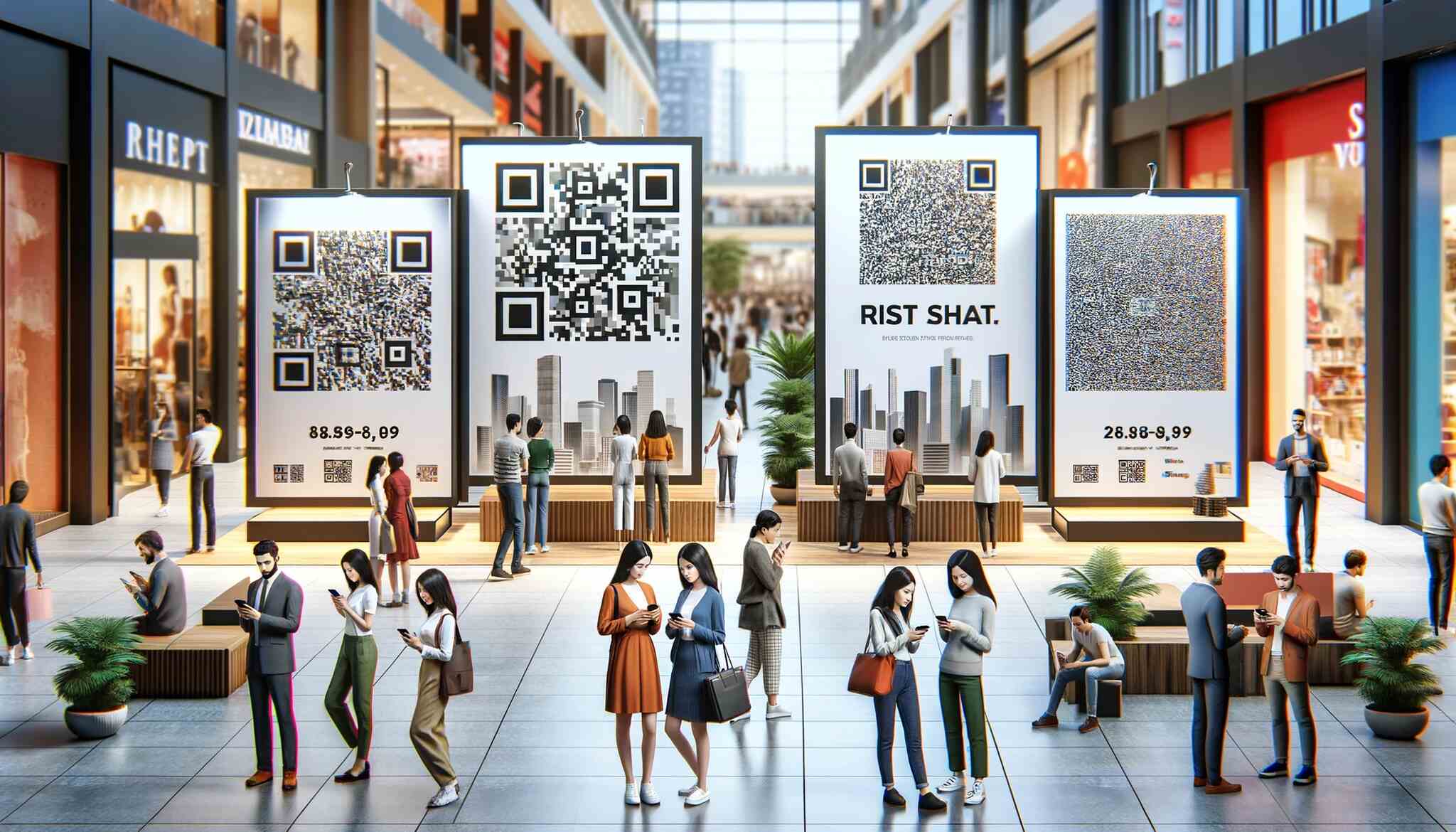
Here, we will explore essential tips and guidelines to help ensure that your QR-coded banners are not only eye-catching but also functional and successful in achieving your marketing goals.
Choose the Right Placement
Placement of the QR code on your banner is critical. It needs to be easily visible and accessible for scanning.
- Eye-Level Placement: Position the QR code where it is most likely to catch the eye of passersby, typically at eye level.
- Avoid the Edges: Keep the QR code away from the edges of the banner to ensure it does not get overlooked or cut off, especially if the banner material flutters or folds.
Ensure Scannability
A QR code that cannot be easily scanned is of no use. Ensuring that your QR codes are scannable is paramount.
- Size Matters: Generally, the QR code should be large enough to be scanned from a distance. A good rule of thumb is that the scanning distance is ten times the size of the QR code.
- Contrast: Use high contrast between the QR code and the background for clear visibility. Black on white is best, but other high-contrast combinations can work well too.
Optimize Content for Mobile
Since mobile devices scan QR codes, the linked content must be mobile-friendly.
- Responsive Design: Ensure that the landing page is responsive and looks good on all screen sizes.
- Fast Loading: Optimize the landing page to load quickly on mobile devices to keep the user's attention.
Use Dynamic QR Codes
Dynamic QR codes offer the flexibility to change the linked URL without needing to change the QR code itself—an invaluable feature for long-term or recurring campaigns.
- Editability: Dynamic QR codes allow you to update the destination URL as needed without reprinting the QR code.
- Tracking: They also provide tracking capabilities so you can see how many people are scanning your QR codes and when.
Keep Design in Mind
The design of your QR code can significantly impact whether or not it is scanned.
- Customization: Customize your QR code to include colors, logos, or designs that fit your brand identity and make the QR code stand out.
- Clarity: Ensure that any customizations do not compromise the clarity and scannability of the QR code.
Test Before You Print
Always test your QR code under different conditions before finalizing your banner design.
- Multiple Devices: Scan the QR code with various smartphones and scanning apps to ensure compatibility.
- Practical Conditions: Test under different lighting and distances to simulate real-world conditions.
Provide a Clear Call to Action
A clear call to action (CTA) tells potential scanners exactly what they will get from scanning the QR code.
- Direct Instructions: Use action verbs to encourage scanning, such as "Scan to discover" or "Scan for a surprise."
- Benefits: Briefly describe what benefit the user will receive from scanning the QR code, such as a discount, more information, or exclusive content.
Monitor and Adapt
Use the data collected from the QR codes to continuously improve your campaigns.
- Analytics: Analyze the tracking data from scans to understand user behavior and preferences.
- Adaptation: Be ready to adapt your strategy based on what the data tells you about the effectiveness of your QR code.
Conclusion
Incorporating QR codes into your banners is a strategic move that can significantly amplify your marketing efforts.
By bridging the gap between offline and online worlds, QR codes enhance user engagement, provide measurable metrics, and create a dynamic advertising experience tailored to various industries' needs.
Remember to keep your codes accessible and your content mobile-friendly, and always aim for a clear call to action.
Frequently Asked Questions
Why should I use QR codes on my banners?
QR codes on banners offer several benefits:
- Interactivity: They make your banners interactive, allowing for a direct way to engage customers and provide them with instant access to more information.
- Trackability: QR codes are easily trackable, giving you insights into how many people interact with your banner.
- Cost-Efficiency: They reduce the need for extensive printed content, which can be updated without needing a new print.
- Versatility: QR codes can link to any digital content, making your banners versatile tools for marketing.
Can I change the content of a QR code after it has been printed on a banner?
Yes, if you use a dynamic QR code. Dynamic QR codes allow you to change the linked content without altering the QR code image itself.
This feature is particularly useful for long-term campaigns or banners displayed in permanent locations, as it allows you to update the content according to changing needs or marketing strategies.
What size should a QR code be on a banner?
The size of a QR code on a banner should be proportionate to the distance from which it is intended to be scanned.
A general rule of thumb is that the QR code should be at least 1 inch (about 2.5 cm) in size for every 10 feet (about 3 meters) of viewing distance. Ensure the QR code is large enough to be scanned easily without requiring the viewer to move too close.
How do I track the effectiveness of a QR code on my banner?
Most dynamic QR code generators offer built-in analytics features. These can track:
- Number of Scans: How many times was the QR code scanned?
- Scan Locations: Where the scans occur if location services are enabled on the device.
- Time of Scans: When people scan your QR code, it can help them understand peak interest times.
Discover our other blog posts to learn more about QR codes:


